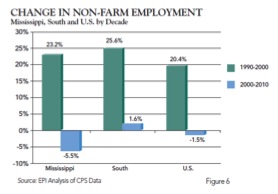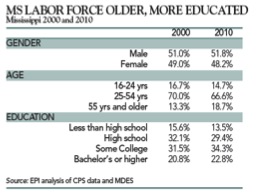State of Working Mississippi 2012 Chapter 1: JOBS
January 26th, 2012
The release of MEPC’s State of Working Mississippi 2012 reveals that the 2000s challenged many Mississippi businesses, as well as working adults and their families. Chapter 1 of the report details trends in the state’s workforce, jobs and unemployment.
CHANGE IN EMPLOYMENT BY DECADE
Mississippi’s job losses in the 2000s appear particularly harsh when compared to the growth of the 1990s (see chart). Mississippi’s employment grew by 23.2% during the 1990s, in contrast to a 5.5% decline in the 2000s. The South experienced similar trends of strong job growth during the 1990s; however, the region did not experience the same level of overall decline in the last decade.
The latest data reveals that Mississippi was one of four states with an unemployment rate still above 10% in December 2011.
SHIFTS IN EDUCATIONAL ATTAINMENT AND AGE OF WORKFORCE
The percentage of workers with at least a bachelor’s degree rose to 22.8% during the decade, and 57.1% of the workforce has taken at least some college coursework. Even with gains, the state’s portion of adults with college experience registers below national norms (60.5%). Overall, more than 350,000 working-age adults still lack a high school diploma and college experience.
Older adults now represent a larger share of Mississippi’s workforce. Throughout the economic downturn in the late 2000s, many Americans delayed retirement to build economic security after suffering financial losses. In 2000, 13.3% of Mississippi workers were age 55 or over. By 2010, 18.7% of Mississippi’s labor force was at least 55 years old. In contrast, younger Mississippians now represent a smaller share of the state’s workforce.
RECOMMENDATION: (For full recommendations see complete State of Working 2012).
Increase wrap around supports for adults in adult basic education, job training and post-secondary courses.Strong wrap-around support services are critical for adults returning to school with the hope of gaining skills and moving into higher wage employment. Without these resources, even the strongest students will struggle to meet both the needs of their families and the demands of training. Examples of supports include: transportation vouchers, child care and staff dedicated to helping adults in adults basic education and GED programs transition to college-level classes.
Tomorrow: The SOW 2012 series continues with a closer look at wages by race, gender and educational attainment.
Author: Sarah Welker, Policy Analyst







